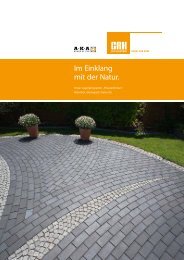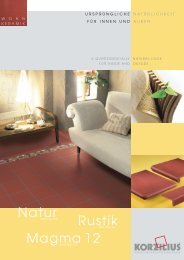You also want an ePaper? Increase the reach of your titles
YUMPU automatically turns print PDFs into web optimized ePapers that Google loves.
Características técnicas Technical information<br />
JUNTAS DE DILATACIÓN:<br />
• Las juntas de dilatación son esenciales en la colocación en exteriores. Su objetivo es absorber los movimientos que sufren las<br />
baldosas con los cambios de temperatura, evitando las tensiones y las fisuras de las piezas cerámicas.<br />
• Se recomienda realizar juntas de dilatación cada 4 m. Como máximo, cada paño tendrá una superficie de 16 m2.<br />
• Debe haber una junta de dilatación perimetral que separe el pavimento de los paramentos verticales , pilares, etc.<br />
• También deben prepararse juntas de dilatación encima de las juntas estructurales propias de la edificación.<br />
• Las juntas de dilatación deben profundizar hasta atravesar aproximadamente 1/3 del espesor del recrecido de mortero sobre<br />
el que se ha pegado la pieza cerámica. De esta forma los posibles movimientos por temperatura romperán la losa de recrecido<br />
por la junta evitando roturas incontroladas por otras zonas que puedan afectar al pavimento superpuesto.<br />
• Las juntas se rellenaran colocando en el fondo un cordón comercial flexible sobre el que se extiende un adhesivo impermeable<br />
tipo Sikaflex que realiza el sellado de la junta. Es muy importante que este sellado final no se desprenda de los espesores de<br />
las baldosas entre las que se ha colocado para evitar la entrada de agua.<br />
• Igualmente la junta perimetral debe rellenarse con el cordón flexible y sellarse con Sikaflex o similar para permitir su movimiento<br />
y evitar la penetración de la humedad debajo del pavimento.<br />
EXPANSION JOINTS:<br />
• Expansion joints are essential when laying tiles outdoors. They absorb movements that might affect the tiles, caused by changes<br />
in temperature, preventing stress forces or cracks in the tiles.<br />
• Expansion joints should be inserted every 4 metres, so that the maximum area covered by a continuous stretch of tiles is 16m2.<br />
• A perimeter expansion joint should be inserted, separating the tiled floor from walls, columns etc.<br />
• Expansion joints should also be inserted on top of the building’s structural joints.<br />
• The expansion joints should penetrate about 1/3 of the depth of the floor screed on which the tiles have been laid. In this way,<br />
the floor screed will crack along the joint in the event of possible movements caused by changes in temperature, avoiding uncontrolled<br />
breaks or cracks in other areas that might affect the tiled surface on top of it.<br />
• Fill the joints with a flexible material and then seal them with a waterproof adhesive sealant like Sikaflex. It is very important<br />
for the final seal to fill the entire tile joint right up to the top surface of the tiles, so as to prevent water from entering it.<br />
• Likewise, the perimeter joints should also be filled with a flexible material and then sealed with Sikaflex or a similar product to<br />
absorb movements and prevent moisture from filtering underneath the flooring.<br />
LIMPIEZA FINAL:<br />
• Para realizar la limpieza final se utilizará agua. En ocasiones se puede añadirá una solución ácida para ayudar a eliminar los<br />
restos del material de agarre y de rejuntado.<br />
• En los distribuidores de materiales de construcción se pueden encontrar quitacementos y otros productos adecuados para<br />
la limpieza final.<br />
THE FINAL CLEANING PROCESS:<br />
• Use water to clean up afterwards. On occasions, an acidic solution can be used to help remove the remains of bonding or<br />
grouting material.<br />
• Cement removers and other suitable products for cleaning up afterwards can also be purchased from building suppliers.<br />
Recomendaciones para la colocación de peldaños<br />
Recommendations for laying step tiles<br />
189<br />
RECOMENDACIÓN GENERAL<br />
Gres de Aragón recomienda en exteriores el uso de adhesivos tipo C2 TE S1 (Adhesivo cementoso mejorado para su uso en<br />
exteriores, con tiempo abierto ampliado y deformable) y material para juntas tipo CG2 (EN 138888). Todos los fabricantes<br />
de cemento cola disponen de este tipo de materiales desarrollados para la colocación en exteriores.<br />
No se descarta la colocación con mortero tradicional, bajo responsabilidad del colocador.<br />
GENERAL GUIDELINES<br />
When tiles are laid outdoors, Gres de Aragón recommends the use of C2 TE S1 type adhesives (improved deformable cement-based<br />
adhesives for outdoor use, with an extended open time) and CG2 type grouting material (grouts for outdoor use<br />
with a low water absorption rate and resistance to abrasion). All manufacturers of cement-based adhesives make materials<br />
of this kind for outdoor use.<br />
It is possible to lay the tiles with the traditional cement mortar method, but the tile layer will be responsible for ensuring the<br />
proper preparation and application of the mix.





